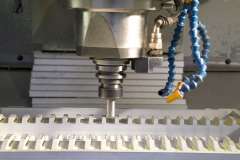Comparing Vac Form Quotes

Comparing Vacuum Forming Quotes – A Checklist for Buyers
Good buying practice generally dictates that when looking to commission a new vacuum forming job, the procurer should ideally get 3 or 4 quotes from different suppliers to get an idea of the right price to pay. By doing this across different suppliers, it should give you a good idea of the right price to pay. And whilst the cheapest quote may look attractive, it's important to ensure that prices are analysed to ensure you are getting a fair comparison.
Once you have identified your supplier short list, issued your RFP (Request for Pricing) and received all the information back, it can be a real challenge to ensure you are comparing quotes on a like-for-like basis.
Here are the things to look out for when comparing vacuum forming quotes:
1. What material will the vacuum forming tool be made from and will it be the ‘right’ material for the job?
Vacuum forming moulds come in many different materials, usually wood, aluminium or resin. The type of material used will depend on a number of things including the level of detail required on the finished product, what the total quantity of finished items will be required and if the tool will be required for future jobs.
Wood and resin tools are much cheaper than aluminium, but don’t necessarily work with longer job runs, or those requiring a more detailed finish. They also have a much shorter life span and can be easier to damage.
Aluminium tools are more costly, but allow for significantly more detail and will work for longer runs or for multiple uses.
Check out or guide to tools here.
2. Tooling Design
If your job is relatively small, then multiple items can be formed from one sheet (depending on the size of the sheet). A vacuum forming tool that makes several parts per sheet will be more expensive than one that creates a single part, but in the long run, it should result in a lower forming cost per product as you will be getting more products per sheet with less insertions into the machine. A multi-part tool should also mean less machine time and a quicker job.
Check if each former has quoted the same number of parts per sheet, or whether it's worth increasing. If the tool exists already, make sure you've given the vacuum formers the correct number of parts per sheet to base their quote on. The number of parts per sheet is also called how many “up”, for example a “2-up” tool.
If you are having a tool made for your job, ensure that you check if you will own the tool outright and if it will be kept exclusively for your future jobs, or used for other customers. If you do get to own the tool outright on completion of the job, are there any contractual obligations for minimum annual order quantity or a cost for tool storage?
3. What material and thickness will be used to make the parts?
There are many types of material that can be used for vacuum forming. Sheets of material naturally become more expensive as they get thicker. As sheets increase in size, the amount of time spent on a machine and energy requirements also increases (as it takes longer to heat up to the correct temperature prior to moulding.
Plus there are other material additions that can be specified, such as oil resistance or special colours, which also can add to the price of raw materials.
Ensure you are getting the right material for your job and that all quotes are based on similar material types and specifications.
4. Finishing
There are many types of finishing available for vacuum forming. Some may not be suitable for your particular job. If a supplier is able to offer a full range of finishing options, there is a good chance that the right method will be offered to meet your requirements.
It’s also important to be clear on how the finished items will be packed and delivered to you. Boxing can add increased timings and costs to a job.
Read our guide to finishing here.
If you can agree many of the above before you ask for quotations, you should be able to request for the information to be completed in a table or set format, which will allow for an easier way to make comparisons before you place your job.
5. On-site capability
Do the companies have all their facilities on-site or are certain parts of the process out-sourced at all? 100% control over your job can keep costs down and more easily managed.
How do the factories operate? Have they completed jobs like yours before? It’s important to know that they can handle your job proficiently. You may be able to take a factory visit to see how your job will be handled too. This can give a good degree of comfort in your decision.
Make sure that delivery times for the completed job are clearly stated and ensure you understand what happens in the case of a delay or issue.
These are just a few of the key points to cover when comparing prices for your plastic parts. If you would like to find out more about the Vacform Group’s quoting process, or to discuss a particular job, please contact us via the website, email or phone.



